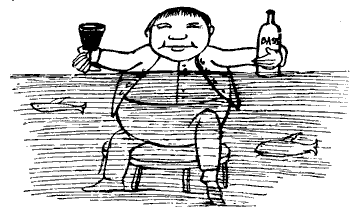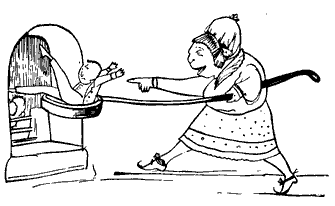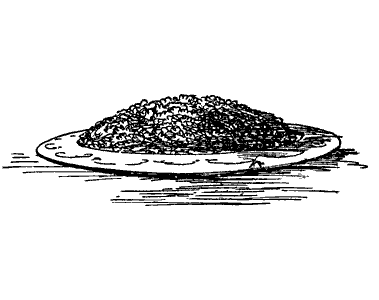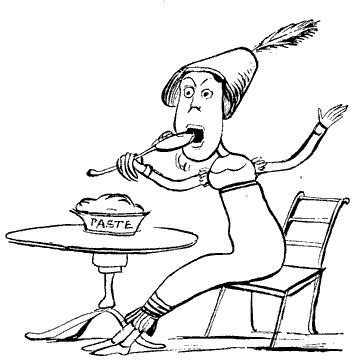Ask most folks why people eat and after the funny look they'll answer something like: "So they don't starve." or "To stay alive." While those are the most obvious reasons people eat, another reason that is nearly as important is to improve or maintain health. Of course people eat for other reasons, too, ranging from pleasure to boredom, but we aren't as concerned with those reasons today.
Way back before the advent of modern medicine, people were using food to modify health and treat illnesses. The first books of medicine were actually cook books. This was not because there weren't medicines available (there were lots of herbs in use) but rather that there is no other factor that determines as much about a person's health as what they eat.
Every time we eat a meal, we have an opportunity to please our taste buds or to please our bodies. It's also possible to do both at the same time. Pleasing the taste buds and the body simultaneously is the only real way to improve health when eating in my humble opinion. What that means is that good-for-you can and should equal good-tasting.
It's no secret that a most diets fail. In fact nearly 95% of dieters regain the weight they've lost. In the United States people spend more than $33 billion per year trying to lose weight with diet programs, special foods and diet beverages. How could so many of us fail so often?
The answer lies in the fact that diets just aren't the way to get or stay healthy. Not only do they have a terrible connotation, but the restrictions to calories, fats and other taste-enhancing components can cause foods to be terribly unsatisfying. Instead of dieting, try changing your eating habits permanently for the better. Making changes to your way of eating instead of following a fad diet offers a much more reliable and flexible option.
Changing the way we eat can be a daunting task. It's definitely not the easiest work to undertake. It can be helpful to take small steps to reach the goal of eating better everyday. An easy way to start down that path is to begin asking yourself if what you are eating is pleasing to taste buds or pleasing to the body or both. Sometimes we aren't necessarily sure if what we are eating is good for us or not and that's ok. There are definitely things we know aren't good for us at all and things we definitely know are better for our health.
'Bad for you' foods are made to appeal to the most basic human desires - usually the craving for fats and/or sweets. Fats and sweets were at one point a rare part of the human diet. We crave them because our bodies need them to run but were historically difficult to find. Our desire for them isn't a bad thing. It's just the way we're wired. However over the course of human development, cooks have been able to exploit the resources available to them and make abundant the very things which were once so rare. The same things that are beneficial in small amounts have become detrimental because they are eaten in excess. What that means is not that we should avoid fats and calories altogether, rather we should learn to incorporate them in our diets in moderation.
The next time you're in a restaurant, look at a menu and examine the foods you find appealing. What kinds of foods are they? Would you consider these foods to be healthy? It's ok to find foods typically considered 'bad for us' appealing. After all, most of the time when we go to a restaurant we are going there to eat for pleasure, and not with our health foremost in our minds.
At this point, you have a choice - eat something 'healthy' that might be less appealing or eat something 'bad' that really appeals to you. In some cases you can be lucky enough to find something 'healthy' and appealing, but often this is not the case. Sometimes there is a happy medium and sometimes there isn't. However using your wits you can manipulate your meal a little to get better nutrition and reduce some of the 'badness'.
Here are some examples:
Scenario 1 - Burger Craving
You are craving a cheeseburger. You have lots of options with this one. You can get one from a fast food joint, from a pub or you can make one at home. You can have french fries with you burger or soup or salad or nothing at all. You can accompany your burger with beer, soda, or water.
The fast food burger is naturally the worst choice. It has little nutritional value and is highly processed. The norm in the fast food restaurant is to serve it with fries and a soda. Fries and a soda are definitely not the healthiest thing you could be eating. If you must eat at the fast food place, try skipping the soda and fries. Have water to drink and in place of fries perhaps add something a bit healthier to your meal like a salad or fruit. You still won't be eating an optimal meal, but you've gotten rid of some of the worst parts.
The pub may offer a better solution. You can get a better quality burger that will have a better nutritional value and you can opt to have salad or soup with your meal instead of fries. Salad is good because it is fresh and provides vegetable nutrients. Soup can either be good or ok, depending on type. Cheese soup is not as good of a pick as minestrone, but it is likely better than fries.
Making the burger at home may be the best solution as you can control the type of meat you are using, what toppings you use and what you eat it with. If you are interested in low carb diet, you can omit the bun and fries and never even be tempted by their presence on your plate. You can add all the veggies you want. You can drink water with your meal or any other favorite beverage. It's a win-win situation.
Scenario 2 - Breakfast
You go to a restaurant for breakfast and you want something satisfying, but you are keeping an eye on your health.
You could have muesli with fruit and yogurt. Though you like how healthy the meal seems, you know you'd be missing the breakfast you really want to eat. You might even eat a second breakfast at home later or make up for it with an extravagant lunch.
You could have pancakes, but really they are nothing more than fried refined flour with lots of syrup on top. There isn't a lot of fiber or nutritional content in them and they are high in sugar. They may be good for the taste buds, but your body will suffer. You'll experience a jump in blood sugar that will be followed by a loss of energy. You will probably be hungry again in a short while.
You could have bacon and eggs with hashbrowns. Though this meal offers significantly more nutrition than the pancakes, there isn't much in the way of fiber or vitamins from vegetables. You're missing out on micro-nutrients and variety. Your meal may also be high in saturated fat.
You could have an omelet. It includes the meat you might crave, but it also features sauteed vegetables. It comes with whole-grain toast and fruit instead of potatoes. This choice is kind of a happy medium since you are still eating a satisfying breakfast that makes you happy, but it includes some vegetables which offer more nutrition and a little more fiber from the toast.
The moral of this story is that when you are just starting out on the path to changing your eating habits, you can simply make choices to improve a meal. Take one step at time to get where you are going. Ask yourself, "Is this the best choice I could be making?" and answer honestly without beating yourself up. Then ask yourself, "Can I make this a better choice?" It's up to you to decide when and how you start making changes in the way you eat.
The biggest hurdles to our goals are usually found in our own minds. Be generous with yourself and patient with yourself. By starting to think about what might make an optimal meal and making small modifications, you are preparing yourself for bigger changes to come. It takes time and learning to see where and how you can improve is an important part of the process. You can do this. Nothing about the process is difficult. It only requires you to want to make the necessary changes.







